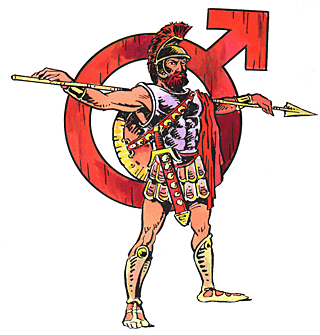Mars,
Mars [Greek: Ares], Roman god of war
(fourth planet from the sun).

Like a badge of blood in the sky, the Red Planet has
long stood for the gods of war.

- It seems natural that the Greeks named the fourth planet after Ares, since the fourth planet shines with a red color, resembling blood, which is appropriate for the god of war.
- The Romans identified their god of war, Mars, with the Greek Ares, so now we know the planet as Mars.
- Mars was the Roman war god; his shield and spear form the planet’s symbol.
- He was one of the most important of the Roman gods and an entire month of the year was dedicated to him.
- We still call the third month of the year, March, in his honor.
- He was also a god of agriculture before becoming associated with Ares.
- The month was so named because Mars, the patron god of the Romans, was a war-god, and spring campaigns usually began about that time.
- The Roman year once began with March before it became January.
- He is characterized as the god who took a savage delight in slaughter, and the hordes of slain upon the battlefield filled him with a fierce joy.
- In the poems of Homer, there are such epithets as these applied to him: scourge of mortals, piercer of shields, the bloodstained one.
- The Romans were well-known as a warlike people; therefore, it is not strange that Mars became their patron god.
- They built temples for him and honored him by many celebrations during the year.
- One of the most famous parts of the city of Rome was called the Field of Mars (Campus Martius), and it was here that the army was reviewed and the spoils of war dedicated after the return of the armies from some successful campaign.
- The word martial, pertaining to war, came from Mars, the god of war.
A few scientific facts about Mars:
- It wasn’t until 1877 that the planet Mars was found to have any satellites; but, in that year, the American astronomer Asaph Hall discovered two of them.
- They were very small, being only five or ten miles in diameter, but they were satellites.
- Hall named them “Phobos” and “Deimos” so that in the heavens, as in the myths and in reality, war is accompanied by fear and terror.
- Mar’s characteristic color is primarily due to the high content of oxidized iron in its surface layers.
- The surface is covered with fine dust that is often whipped up into dust storms by winds blowing at up to 200 mph (325 km/h).
- Water must have flowed on Mars at some time.
- The evidence comes from photos of the Valles Marineris taken by the Viking 1 orbiter (launched in 1975 and reaching Mars on July 20, 1976).
- The Valles Marineris is a system of canyons and cracks of geological origin in the surface of the planet.
- Some of them show signs of water erosion, with clearly marked tributaries and winding, dried-up riverbeds.
- No one is certain when the water was there, but it is assumed to have been many millions of years ago.
 You may return to the page of planet images from here.
|